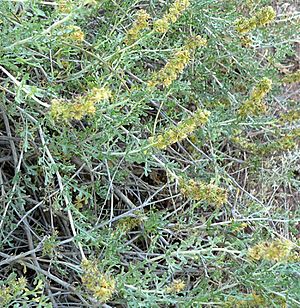Burro-weed facts for kids
Quick facts for kids Burro-weed |
|
|---|---|
 |
|
| Scientific classification | |
| Genus: |
Ambrosia
|
| Species: |
dumosa
|
| Synonyms | |
|
|
Burro-weed, also known as white bursage (its scientific name is Ambrosia dumosa), is a plant found in North America. It belongs to the sunflower family. You can often see it growing in the Mojave Desert and Sonoran Desert. These deserts are in places like California, Nevada, Utah, Arizona, and parts of Mexico.
Scientists have studied how burro-weed interacts with other plants. For example, the creosote bush makes a chemical. This chemical can stop burro-weed from growing well. Other studies suggest that burro-weed roots also make a chemical. This chemical helps their roots grow away from other burro-weed roots. This way, they don't compete for water. Besides burro-weed, people also call it bur sage or burro bush.
Contents
What Burro-weed Looks Like
Ambrosia dumosa is a type of ragweed. It is a very branched shrub. It usually grows to be about 20 to 90 centimeters (8 to 35 inches) tall. The younger stems of the plant are covered with soft, gray-white hairs.
Leaves and Stems
The leaves are shaped like an oval, wider at the top. They are often divided into smaller parts or deeply lobed. These leaves are usually grouped together on short branches. They are about 0.5 to 4 centimeters (0.2 to 1.6 inches) long. Like the stems, the leaves are also covered in soft, gray-white hairs.
Flowers and Fruit
The flowers of burro-weed are yellow. Each plant has both male and female flower parts. The male flower heads have many flowers. They are about 3 to 5 millimeters (0.1 to 0.2 inches) across. The female flower heads have only two flowers. They do not have petals.
The fruit of Ambrosia dumosa looks like a small, round bur. Its color can be golden, purple, or brown. The fruit has tiny hairs. It also has 12 to 35 flat, straight spines. These spines are about 5 to 9 millimeters (0.2 to 0.35 inches) long. They are spread out over the fruit's surface.
How Burro-weed Survives in the Desert
Burro-weed is very good at living in dry places. When there is a drought, it loses all its leaves. This helps the plant save water. This is called being "drought deciduous." Even without leaves, you can still recognize it. Look for long stripes on its smaller stems.
Like other ragweed plants, burro-weed pollen can cause allergies. The wind carries its pollen. As more people move to desert areas, like near Joshua Tree, California, and Las Vegas, Nevada, more people are experiencing allergic reactions.

